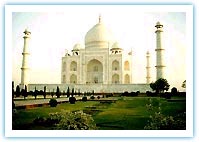



    |
 of Agra is world famous for the Taj Mahal, built by the Mughal emperor Shahjahan
in memory of his beloved wife. However, it is also famous for the Agra Fort,
which is a veritable treasure trove of the Mughal architectural tradition.
of Agra is world famous for the Taj Mahal, built by the Mughal emperor Shahjahan
in memory of his beloved wife. However, it is also famous for the Agra Fort,
which is a veritable treasure trove of the Mughal architectural tradition.
The various buildings within this sprawling fort complex represent the assimilation of different cultures, which was the mark of the Mughal period.
MUGHAL STYLE OF ARCHITECTURE
The structure of Taj Mahal adheres to the Islamic style (Mughal style) of
architecture, which flourished in India during the medieval period. The Islamic
style of architecture is also referred to as the Indo-Islamic style of architecture.
This magnificent monument is set around a Charbagh or ‘four garden’ plan, which is split by watercourses - a reflection of the Persian style. The Taj Mahal itself is not set within the Charbagh but is located towards the far end of the enclosure near the bank of river Yamuna.
Taj Mahal is built on a high plinth, which has four tapering minarets at each corner. At the center of this plinth is an octagonal structure comprising of a central hall, with four smaller halls grouped around it.
A central bulbous dome stands atop the roof of the Taj that is surrounded
by four chhatris (domed canopy, supported by pillars, mainly seen in Hindu
or local monuments and sometimes in Islamic buildings).
The Taj Mahal is a two-storied structure, each having arched recesses with
a highly decorated iwan in the middle. The tombs of Mumtaz Mahal and Shahjahan
are actually located in the basement, while their replicas are placed directly
above in the upper hall.
The Taj Mahal is entirely made of white marble and its pure white walls are decorated with exquisite pietra dura (stone inlay) work. It is said that different types of precious and semi-precious stones were used in the intricate inlay work done on Taj Mahal.
In spite of its massive proportions, Taj Mahal looks weightless and airy.
Each section of this unique monument blends harmoniously with each other to
create a perfect unit. The Taj Mahal and the gardens in front of it can be
approached through an arched gateway.
Click
here for More Details......
| Rajasthan || Kerala || Goa || Taj Mahal || Wildlife || India Hotels || India Travel Guide || Beaches || Honeymoon |
| HOME | ABOUT US | CONTACT US | RESERVATION | EMAIL |
| Copyright © All Right Reserved MIDTOWN TRAVELS PVT. LTD. |